Philip Leslie Hale
Philip Leslie Hale (1865–1931) was an American Impressionist artist, writer and teacher.
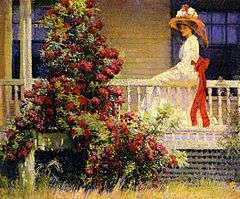
.jpg)
Biography
Hale was born in Boston, the son of prominent minister Edward Everett Hale, the brother of artist Ellen Day Hale, and was related to Nathan Hale and Harriet Beecher Stowe. He studied at the School of the Museum of Fine Arts in Boston under Edmund Tarbell, and with Kenyon Cox and J. Alden Weir at the Art Students League of New York. Beginning in 1887 he studied in Paris for five years, and during the summers painted at Giverny, where he was influenced by the palette and brushwork of Claude Monet. In the 1890s he painted his most experimental works, which evidenced an interest in Neo-impressionism and Symbolism.
Hale returned to Boston in 1893. Formerly engaged to Ethel Reed, he instead married fellow artist Lilian Westcott Hale in 1902, and they rented adjoining studios in Boston. Hale taught at the Museum School in Boston, as well as the Metropolitan Museum of Art and the Pennsylvania Academy of the Fine Arts; among his Boston pupils was Mary Bradish Titcomb.[1] He wrote art criticism and published Jan Vermeer of Delft in 1913, the first monograph on the artist published in the United States.
- Works
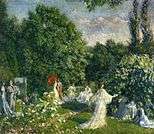 Garden party
Garden party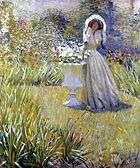 Woman in garden
Woman in garden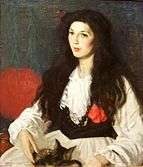 Portrait
Portrait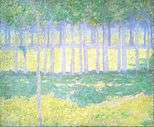 Landscape
Landscape
See also
References
- Eleanor Tufts; National Museum of Women in the Arts (U.S.); International Exhibitions Foundation (1987). American women artists, 1830–1930. International Exhibitions Foundation for the National Museum of Women in the Arts. ISBN 978-0-940979-01-7.
- Dearinger, David Bernard. Paintings and Sculpture in the Collection of the National Academy of Design: 1826-1925, Hudson Hills, 2004. ISBN 9781555950293
- Philip Leslie Hale papers, Smithsonian Archives of American Art In 1917 he was elected into the National Academy of Design as an Associate member.
External links
- American Impressionism and garden movement
| Wikimedia Commons has media related to Philip Leslie Hale. |